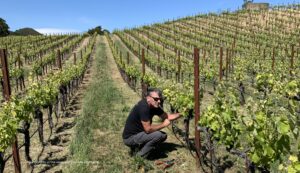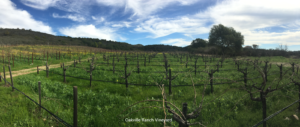When I’m taking my last sips out of the last glass poured from my last bottle of Paul and Jackie Gordon’s Halcón Vineyards wine someday, this is what I hope to remember to tell myself. Though I managed to miss the boat on a decade’s worth of Halcón vintages, I’m grateful that I came across this excellent, Rhône-centric label when I did. The truism above certainly applies.
I’m also glad to have had a chance to meet the Gordons, the now-former owners of this Yorkville Highlands vineyard, on a cold, rainy night in early 2019, while we all poured wines for a group of wine competition judges in a funky Cloverdale art gallery. Paul and Jackie had their Yorkville syrah to show off to the judges; I had a few library vintages of my bosses’ wine from the same AVA. Since then, I’ve become a bit obsessed with the English couple’s syrahs, along with their equally intriguing mourvèdre.
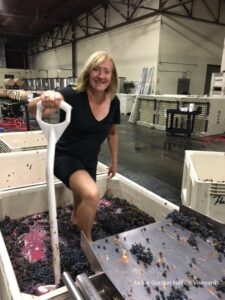 As I mentioned at the end of part one, they put their vineyard on the market earlier this year as they plan a move back to Europe. The high-elevation property would, I had little doubt, attract plenty of interest. But it meant that in the future, lovers of California syrah and other Rhône varieties would be deprived of a dynamic label and its eminently site-specific wines—or at least the Gordons’ renditions.
As I mentioned at the end of part one, they put their vineyard on the market earlier this year as they plan a move back to Europe. The high-elevation property would, I had little doubt, attract plenty of interest. But it meant that in the future, lovers of California syrah and other Rhône varieties would be deprived of a dynamic label and its eminently site-specific wines—or at least the Gordons’ renditions.
For his part, Paul seemed upbeat about the sale. I emailed him back in May that I hoped the vineyard would find an enthusiastic buyer, and otherwise wished him the best of luck. He replied that, if all went well, they might end up in northern Portugal, or maybe northwest Spain.
Halcón has subsequently been purchased by a pair of ambitious and accomplished vintner-partners. Esther Mobley reported on it last month in the San Francisco Chronicle. “The Halcón Vineyard is very much a wine insider’s secret,” the paper’s wine editor wrote. “Now that it has two high-profile owners, it is certain to become less of a secret.”
I just hope these new owners don’t double the prices of the extraordinary wines that earned the couple a devoted following, though I suppose they had to fork over a lot of cash to make the deal happen. In any case, it would help burnish the Gordons’ reputation in California for their own ambitious viticulture.
It reminds me of another truism, this one from the Bard himself: “All’s well that ends well.”
• • • • •
Down at Tablas Creek Vineyard, Jason Haas isn’t going anywhere.
Which is to say, the busy Partner and General Manager of the Paso Robles winery is probably always going somewhere, but there’s a dependable permanence to the wine estate his father, Robert Haas, founded back in the late 80s with a French winemaking family. From then to now, Tablas Creek has been one of the standard-bearers for Rhône and Mediterranean grape varieties in California.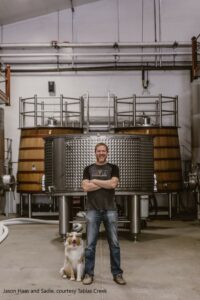
The Haas family’s partners, the Perrins, are proprietors of Château de Beaucastel in the southern Rhône appellation of Châteauneuf-du-Pape. At this famous estate, they grow all thirteen red and white grape varieties approved in the Châteauneuf appellation. And at Tablas Creek, in an impressive demonstration of viticultural solidarity with their business partners, the Haases grow the same thirteen grapes, plus three additional varieties. They plan to add a few more to reflect the full lineup of approved vines in the larger Côtes-du-Rhône appellation.
The Paso Robles operation got off the ground in 1989 in the Adelaida community just west of the small Central Coast city, which preceded the creation of the Adelaida District AVA by about 25 years. Tablas Creek’s founding occurred in tandem with the Haases establishing their own nursery to quarantine the vines they’d imported from Beaucastel, per the USDA’s strict regulations to assure they were free of viruses. These were, and are, dedicated people.
While working earlier this year on a two-part article about Once & Future mataro, I sent Jason an email through his director of marketing, Ian Consoli, to ask if a related conversation about the synonymous mourvèdre they grow and produce at Tablas Creek might be possible. It was all in the name of further indulging my pandemic mourvèdre/mataro obsession. “I’d be happy to talk about Mourvèdre,” the GM wrote back. “I spend a disproportionate amount of my time thinking about it.”
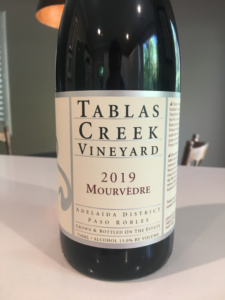 I’d met Jason once before, a number of years ago during a Rhône Rangers trade tasting held in downtown Los Angeles at Vibiana, the city’s deconsecrated Catholic cathedral. The former church was repurposed in 2005 as an events venue for more secular gatherings, like wine tastings. Tablas Creek had their table arranged in front of one of Vibiana’s carved wood confessionals that still lined its walls. To the Southern California retailers and restaurateurs who gathered around, Jason spent the afternoon confessing, as it were, his love of Rhône varieties and wines.
I’d met Jason once before, a number of years ago during a Rhône Rangers trade tasting held in downtown Los Angeles at Vibiana, the city’s deconsecrated Catholic cathedral. The former church was repurposed in 2005 as an events venue for more secular gatherings, like wine tastings. Tablas Creek had their table arranged in front of one of Vibiana’s carved wood confessionals that still lined its walls. To the Southern California retailers and restaurateurs who gathered around, Jason spent the afternoon confessing, as it were, his love of Rhône varieties and wines.
As I briefly covered in the first part, the winery’s website has a section devoted to individual entries for the Rhône-Mediterranean grapes grown on the 120-acre property. I assume Jason, who is an active blogger and talented writer about wine, had something to do with this thorough vine index; the list isn’t alphabetized, so, given his preoccupation, it’s no surprise that mourvèdre is the grape that gets top mention.
“We’ve been growing it since our first harvest in 1995, but the first varietal mourvèdre that we made was ’02 or ’03,” he said over the phone in late July. Unsurprisingly, he’d been on the road at the time I caught up with him.
Jason told me that Tablas Creek started out making wines based on blended varieties. “Mourvèdre was always the lead grape in the vineyard. But the initial plans were not to bottle it on its own because the plans were not to bottle any varieties on their own,” he explained.
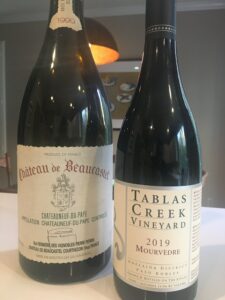 A significant portion of vineyard land at Tablas Creek is devoted to mourvèdre. On the winery’s website, they describe it as having the largest footprint of any grape, representing more than a third of the estate’s 120 acres. But the “lead grape” the GM noted is, varietally speaking, just one piece of their flagship bottling, Esprit de Tablas, and the other red blends they produce. Like Châteauneuf-du-Pape, those wines are very much the sum of their parts.
A significant portion of vineyard land at Tablas Creek is devoted to mourvèdre. On the winery’s website, they describe it as having the largest footprint of any grape, representing more than a third of the estate’s 120 acres. But the “lead grape” the GM noted is, varietally speaking, just one piece of their flagship bottling, Esprit de Tablas, and the other red blends they produce. Like Châteauneuf-du-Pape, those wines are very much the sum of their parts.
If you can picture a pie chart of grapes permitted in the famous Rhone appellation—and in the case of Beaucastel, actually grown in its vineyards—it would be comprised of thirteen red and white slices, with grenache and syrah the two biggest and most familiar. Tablas Creek’s chart would look very similar, but divided up into even more slices. Given my own preoccupation of the past year and a half, the slice of mourvèdre pie was the one I most wanted to taste.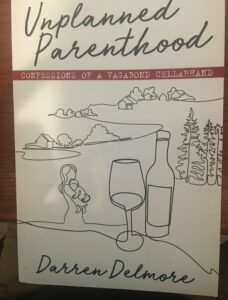
So I got in touch with Darren Delmore, Tablas Creek’s national sales manager. I’d connected with him earlier this year through a mutual friend. Afterward, Darren, who’s an author and journalist on the side, sent me a copy of his rather spicy 2020 book, Unplanned Parenthood: Confessions of a Vagabond Cellarhand. I’m no book reviewer, but if I were, it would be fun to unpeel the layers in this Maui onion of a memoir. In the end—spoiler alert!—it’s a touching tale that relates back to the title. For my own seven-word summary of the book, I’ll try this: wine, beer, weed, sex, roasted meat, repeat.
Neil Collins and his winemaking team have made nearly twenty vintages of mourvèdre at Tablas Creek. The most recent of these, the 2019, was what Darren sent me over the summer. The bottles sat in their box for a week or two, then an opportunity arose to share one of them with some wine colleagues here in Napa.
• • • • •
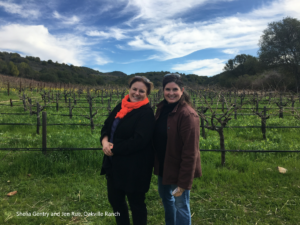 Jennifer Rue and Shelia Gentry are, respectively, the winemaker and general manager at Oakville Ranch. I was meeting them at Materra, the new-ish winery just up the road from us in the Oak Knoll District where Jen makes the Oakville Ranch wines, to interview them for a separate article. We tasted a few cabernet-based wines from the ranch, from grapes grown high up on a plateau in the hills of east Oakville. Then I opened the Tablas Creek. If we needed a reminder of the contrast between Napa Valley and Paso Robles wines—or more specifically between Oakville and Adelaida—here it was.
Jennifer Rue and Shelia Gentry are, respectively, the winemaker and general manager at Oakville Ranch. I was meeting them at Materra, the new-ish winery just up the road from us in the Oak Knoll District where Jen makes the Oakville Ranch wines, to interview them for a separate article. We tasted a few cabernet-based wines from the ranch, from grapes grown high up on a plateau in the hills of east Oakville. Then I opened the Tablas Creek. If we needed a reminder of the contrast between Napa Valley and Paso Robles wines—or more specifically between Oakville and Adelaida—here it was.
I poured a taste for Shelia, and after nosing her glass, she seemed excited. “Personally, I love Rhône varietals. I always think of these wines as ‘dessert.’ They’re so refreshing after a big cabernet. It’s just super-different, its floral nose.”
“And it scratches that kind of particular itch,” Jen added with a laugh, swirling the mourvèdre in her glass. My fellow Angeleno is good-natured and has a sense of humor about winemaking, but I’ve figured out she’s also one of the more eloquent people I’ve heard describing how a wine smells and tastes.
She dove in with a confession, of sorts. “You know, being in cabernet country, one of the things that I always wrestle with is that the food that I eat doesn’t necessarily match the wines that I’m making all the time. I’ve kind of had to throw that away and just be like, ‘I’m drinking cabernet with everything, and then see what happens!’”
We weren’t eating anything at Materra, just talking and tasting. Though I figured Jen was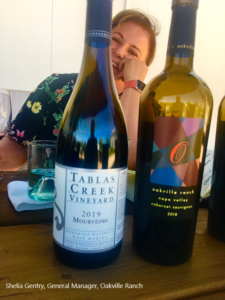 only half serious about a cabernet-only diet, the mourvèdre seemed to offer both women some genuine palate intrigue. “The beauty of it for me, on the nose, is that there’s ripeness,” Jen said before tasting the wine. “But there’s also a brightness, a kind of ‘spaciousness’ where it’s like, you can have this concentration of aromas. I haven’t put it in my mouth yet, but based on the color and what I’m receiving from the nose, there’s going to be a brightness and a lightness in the palate.”
only half serious about a cabernet-only diet, the mourvèdre seemed to offer both women some genuine palate intrigue. “The beauty of it for me, on the nose, is that there’s ripeness,” Jen said before tasting the wine. “But there’s also a brightness, a kind of ‘spaciousness’ where it’s like, you can have this concentration of aromas. I haven’t put it in my mouth yet, but based on the color and what I’m receiving from the nose, there’s going to be a brightness and a lightness in the palate.”
She and Shelia had brought along their newly released cabernet sauvignon, cabernet franc, and an old-school field blend of zinfandel and petite sirah. This last wine would theoretically line up closer to mourvèdre, a variety that’s both modern and ancient (or “ancient”) in California and ends up in no shortage of similar field blends. Jen’s evaluation was a little more encompassing: though the Tablas Creek and Oakville Ranch wines displayed distinct flavors and aromas, all of them shared a characteristic that she put in quasi-visual terms. Her comparison was new to me.
“I think where I’m seeing some parallels is there’s an ‘illumination’ within this wine, which is one of things about the Tablas Creek wines that I really appreciate,” she said. “It’s sort of like there’s a brightness. You know, if you think about it as a picture, well, it’s like you’re looking at the same picture and you turn the lights on. Then you can actually see what’s going on, right? It’s a little bit more in focus. So I think that with the acid structure of the wines that we make at Oakville Ranch, the way it can kind of carry through your mouth, there’s enough ‘activity’ where there’s that illumination. You can kind of see what’s happening and experience what’s happening. I feel the same thing going on here in this wine, and I really, really like it.”
Over a short amount of time that afternoon, Shelia and Jen gave the Tablas Creek mourvèdre some close, professional consideration. They were also like a couple of kids playing with a new toy. The mourvèdre seemed to delight them both.
“It’s a grape that thrives in the sun, and it thrives in the heat” of Paso Robles, Jason Haas shared during our July call. I’d asked for a couple of verbal tasting notes on the mourvèdre. The long stretch of Tablas Creek vintages allow him to deliver some well-formulated thoughts on the grape and how it performs as a varietal bottling at his family’s winery. I recalled this from his holding forth at the Vibiana tasting in Los Angeles. But there was nothing formulaic about his pure delight with this latest vintage, or most that came before it.
“It maintains freshness, it maintains complexity, and it doesn’t get too boozy or too jammy,” Jason said. “It still has earth and loam and spice. We generally pick it at something like twenty-two brix. So it’s like thirteen percent potential alcohol, and it’s got a lot of flavor and structure and tons of savory-ness, which I really love.”
Unlike Tablas Creek, there’s no mourvèdre planted up at Oakville Ranch, nor any syrah. But there is grenache, which Jen crushed last year to make a delicious dry rosé—another wine itch getting scratched. Except in fire-decimated years like 2020, her highly respected vineyard manager, Phil Coturri, accesses some of the grapes for his own red wine under the À Deux Têtes label.
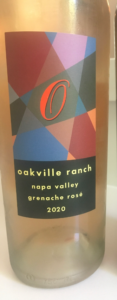 For the detailed impressions they shared, I’d include this pair of women in the larger audience of Rhône wine enthusiasts who happen to be Napa Valley winemakers or other folks in the cabernet business. There’s a deep appreciation among them for syrah, in particular, but also grenache and mourvèdre. Many have told me over the years that they love to drink wines made from this trinity of grapes. I think if I had a dollar for each time I’ve heard this, I could buy a really good bottle of Châteauneuf-du-Pape.
For the detailed impressions they shared, I’d include this pair of women in the larger audience of Rhône wine enthusiasts who happen to be Napa Valley winemakers or other folks in the cabernet business. There’s a deep appreciation among them for syrah, in particular, but also grenache and mourvèdre. Many have told me over the years that they love to drink wines made from this trinity of grapes. I think if I had a dollar for each time I’ve heard this, I could buy a really good bottle of Châteauneuf-du-Pape.
[End of Part Two — More mourvèdre from California and Australia coming in parts three and four.]
